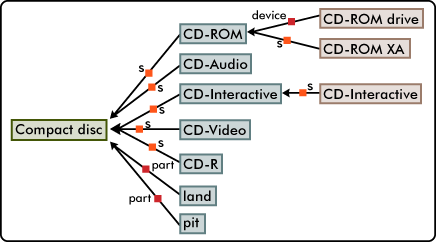ARCHIVED 2.2.2. Knowledge Structures
Archived Content
Information identified as archived is provided for reference, research or recordkeeping purposes. It is not subject to the Government of Canada Web Standards and has not been altered or updated since it was archived. Please contact us to request a format other than those available.
Consult the Pavel in ...
Español Português Italiano Nederlands العربية
Knowledge can be defined as information about what has been perceived, discovered or learned regarding objects in the world around us. Such objects may be concrete (e.g. food) or abstract (e.g. thought process); they may denote relationships (e.g. parallel, partner, equality), functions (e.g. friction), or activities (e.g. prevention and maintenance).
Through intellectual processes such as abstraction and conceptualization, objects are categorized into classes or models called concepts, distinguishable from one another by sets of characteristics. In terminology research, concepts are named or designated by terms, and identified by sets of characteristics, sometimes called semantic features. (For more information on this subject, see ISO/FDIS 704, 2000) Thus, in terminology, knowledge structures are sets of interrelated concepts.
The following image, taken from the CODE Graphical Browser, shows concepts with Generic-Specific (S), Meronymic (Part), and Non-hierarchical (Device) Links, as proposed by I. Meyer, K. Eck and D. Skuce in Systematic concept analysis within a Knowledge-Based Approach to Terminology (WRIGHT/BUDIN 1997:110)

Code Graphical browser showing concepts with Generic-Specific (S), Meronymic (Part), and Non-hierarchical (Device) links.
| Term | Related term | Relationship of related term to term |
|---|---|---|
| Compact disc | CD-ROM | Generic-Specific (S) |
| Compact disc | CD-Audio | Generic-Specific (S) |
| Compact disc | CD-Interactive | Generic-Specific (S) |
| Compact disc | CD-Video | Generic-Specific (S) |
| Compact disc | CD-R | Generic-Specific (S) |
| Compact disc | land | Meronymic (part) |
| Compact disc | pit | Meronymic (part) |
| CD-ROM | CD-ROM Drive | Non-hierarchical (Device) |
| CD-ROM | CD-ROM XA | Generic-Specific (S) |
| CD-Interactive | CD-Interactive | Generic-Specific (S) |
The task of building such systems and structures primarily rests with knowledge engineers and specialists of each field. However, terminologists must familiarize themselves with this kind of work and be able to use such classifying information in the first stages of any terminology-related research.
Encyclopedias, manuals, and knowledge-based information management systems such as those found in learning organizations can also provide you with the framework required to establish or adopt a subject-field classification system for the subject area in which you may be called upon to perform terminology research.
- Date modified: